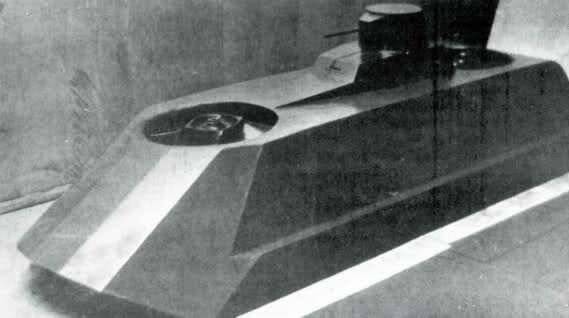Unusual tanks of Russia and the USSR. 1937 hovercraft tank

Engineer V.I. Levakov, one of the first in our country, decided to design and build a car devoid of the shortcomings inherent in tanks with a classic tracked vehicle. As conceived by the designer, the future machine was supposed to easily overcome obstacles, both water and swamps or the area covered with deep snow, and with the same speed. Considering that most of the territory of the Soviet Union did not have roads and was difficult to reach, hovercraft (SVP) could effortlessly transfer troops and various cargoes to the most distant and impassable areas for military operations. Also for this type of vehicles, minefields with anti-personnel or anti-tank mines are not an obstacle, since the specific pressure exerted by the air cushion on the ground is unusually low, the fuses installed in the mines are simply not designed for such a small pressure and do not work.
After testing the L-1934 and L-35 air-cushion boats carried out in 1-5, already in 1937 V. I. Levakov with a group of engineers from factory # 84 began work on a project called the "amphibious approaching tank". The L-1934 boat, created by him in 1, was taken as the basis for the future machine. In a short time, drawings and diagrams were made, as well as a model of an air cushion tank in a quarter of its real size. According to the project, the armored hull of the car was assembled from rolled armor with a sheet thickness of 8 to 13 mm, which were fastened with a large angle of inclination, on the corners of steel by welding, that is, the hull was not riveted, but welded. With its smooth outlines of the armored hull, the car was very similar to the boats of V.I. Levakov, L-1 and L-5. The thickness of the bulletproof armor of the hull was: forehead - 13 mm, feed - 8 mm, tower - 13 mm. In the head and tail of the machine were two nine-cylinder, star-shaped aviation M-25 engine, 750 hp (an analogue of the American Wright R-1820-F3 engine produced in the USSR under license at the Perm plant # 19). The design weight of the vehicle was 8,5 tons, based on calculations that the pressure of the air cushion on the ground will be about 0,06-0.07 kg per square centimeter, then the total power of the two propulsion engines was able to lift the tank to a height of thirty centimeters and allowed it to develop the maximum speed up to 120 km per hour.
Movement control and maneuvering of the machine was carried out by changing the flow of the air jet by changing the angle of the louver shutters, as well as by decreasing or increasing the engine speed. In the middle part of the armored corps there was a combat compartment that contained two crew members, a driver and a commander of the vehicle, he was also a turret gunner. Armament of the tank was one 7,62 tank gun DT-29, installed in the tower of circular rotation, installed in the center, on the roof of the vehicle body. However, the project did not seem promising to the military department and was rejected as it was not representing military and technical value, just like another similar project of an air cushion by the engineer Grakhovsky, which was being worked on at the same time. More projects of tanks and armored cars on an air cushion in the USSR were not developed until the middle of the 20th century. However, foreign projects of air-cushion tanks developed in 30-ies, also failed, none of them was brought to completion, and many, like the project of the engineer V. I. Levakov, remained only on paper.
Information